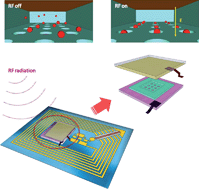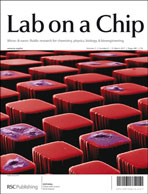We report the first microfluidic device integrated with a printed RF circuit so the device can be wirelessly powered by a commercially available RFID reader. For conventional dielectrophoresis devices, electrical wires are needed to connect the electric components on the microchip to external equipment such as power supplies, amplifiers, function generators, etc. Such a procedure is unfamiliar to most clinicians and pathologists who are used to working with a microscope for examination of samples on microscope slides. The wirelessly powered device reported here eliminates the entire need for wire attachments and external instruments so the operators can use the device in essentially the same manner as they do with microscope slides. The integrated circuit can be fabricated on a flexible plastic substrate at very low cost using a roll-to-roll printing method. Electrical power at 13.56 MHz transmitted by a radio-frequency identification (RFID) reader is inductively coupled to the printed RFIC and converted into 10 V DC (direct current) output, which provides sufficient power to drive a microfluidic device to manipulate biological particles such as beads and proteinsvia the DC dielectrophoresis (DC–DEP) effect. To our best knowledge, this is the first wirelessly powered microfluidic dielectrophoresis device. Although the work is preliminary, the device concept, the architecture, and the core technology are expected to stimulate many efforts in the future and transform the technology to a wide range of clinical and point-of-care applications.

You have access to this article
 Please wait while we load your content...
Something went wrong. Try again?
Please wait while we load your content...
Something went wrong. Try again?


 Please wait while we load your content...
Please wait while we load your content...